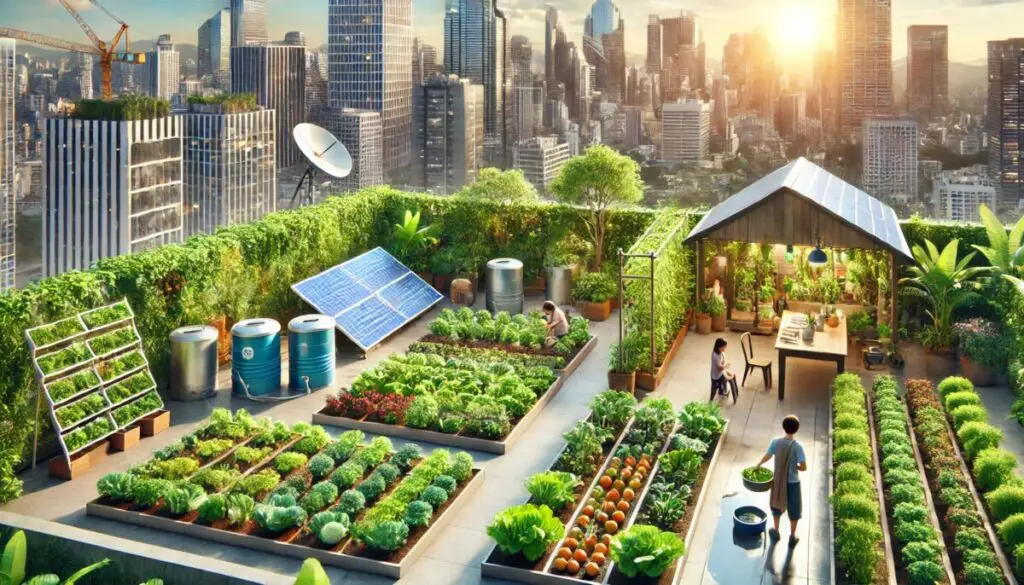
Urban farming is more than just a trendy pastime—it’s a movement that’s reshaping our cities, one garden at a time. With its promise of fresh, local produce, urban farming is often hailed as the eco-friendly hero in the battle against environmental degradation. Yet as with any movement, a mix of excitement and misconceptions has emerged. In this article, we’re separating myths from facts, diving deep into the environmental impact of urban farming, and exploring how we can make this practice even more sustainable.
Understanding the Landscape: Why Urban Farming Matters
As urban areas sprawl and traditional agricultural lands shrink, cities are increasingly turning to urban agriculture as a viable solution. By reimagining vacant lots, rooftops, and even sidewalks, communities can cultivate fresh produce, reduce their reliance on long-haul food transport, and reconnect with nature. But while the narrative is often overwhelmingly positive, some myths have taken root alongside the facts. Let’s explore these head-on.
The Myths About Urban Farming
Myth 1: Urban Farming Is Always Eco-Friendly
It’s easy to think that growing food in the heart of a city automatically equals a green solution. The assumption is that any form of urban agriculture is inherently sustainable. However, the reality is more nuanced. Poorly managed urban farms—especially those that rely on excessive resource inputs or unsustainable practices—can inadvertently contribute to environmental strain. Proper planning and sustainable techniques are key.
Myth 2: Urban Farming Requires No Significant Resources
A common misconception is that urban farms operate magically without resource costs. In truth, even small-scale urban farms need water, soil amendments, and energy inputs. Whether it’s powering a hydroponic system or managing irrigation in a rooftop garden, these resource needs must be balanced with sustainable practices to truly yield an environmental benefit.
Myth 3: Urban Farming Can Replace Large-Scale Agriculture
While urban farming is promising for community food security and local freshness, expecting it to single-handedly replace traditional agriculture is unrealistic. Urban farms typically operate on a smaller scale and are best viewed as a complement to, rather than a replacement for, large-scale agricultural systems. Their true value lies in mitigating food deserts and supporting local economies.
Myth 4: Urban Farming Is Too Small-Scale to Make a Real Difference
Some critics say that because urban farms are often modest in size, their environmental impact is negligible. But consider the ripple effects: every patch of green introduced into urban spaces not only produces food but also improves air quality, combats the heat island effect, and boosts local biodiversity. The collective impact, when multiplied across cities, is far more significant than it might appear at first glance.
The Facts: How Urban Farming Positively Impacts the Environment
Fact 1: Reduction in Food Miles and Carbon Emissions
One of the biggest wins of urban farming is the drastic reduction in food miles—the distance food travels from producer to consumer. By growing produce close to where it will be consumed, urban farms help reduce fossil fuel consumption, lower transportation emissions, and contribute to a smaller carbon footprint. This local approach can significantly cut down the environmental costs associated with long-haul food distribution.
Fact 2: Transforming Unused Spaces into Green Oasis
Urban farming turns neglected spaces—abandoned lots, underutilized rooftops, and barren plots—into thriving, green environments. This not only beautifies cities but also helps combat urban sprawl by reintroducing natural elements into concrete jungles. These initiatives can also play a role in stormwater management and reduce the urban heat island effect.
Fact 3: Promoting Sustainable Practices
Many urban farms are ground zero for sustainable practices such as composting, water recycling, and organic farming. Techniques like rainwater harvesting, natural pest control, and the use of renewable resources contribute to a cyclical, eco-friendly ecosystem. These practices not only benefit the immediate garden but also serve as educational models for broader community adoption of sustainable living.
Fact 4: Enhancing Urban Biodiversity
Introducing green spaces into urban environments creates habitats for various species, from pollinators like bees and butterflies to birds and beneficial insects. This boost in biodiversity can help maintain ecological balance in cities, contributing to healthier urban ecosystems. Every new garden adds a small but essential piece to the intricate puzzle of urban wildlife support.
Fact 5: Strengthening Community Resilience and Awareness
Urban farms often serve as community hubs. They’re places where residents come together to share knowledge, skills, and produce. This community aspect isn’t just socially beneficial—it also has environmental implications. Community gardens can empower individuals to make eco-conscious choices, spur local environmental advocacy, and spread awareness about sustainable practices on a broader scale.
The Environmental Challenges and How to Overcome Them
While the benefits are impressive, urban farming isn’t without its challenges. Recognizing these areas can help us refine techniques and bolster sustainability:
- Resource Management: Urban farms must balance water, soil, and energy usage. Innovative solutions like low-flow irrigation, drought-tolerant crops, and soil regeneration techniques are essential.
- Waste Management: The effective handling of organic waste—through composting or anaerobic digestion—not only enhances soil quality but also prevents additional waste from burdening urban landfills.
- Integration with Urban Infrastructure: Striking a balance between urban development and agricultural space can be difficult. Advocating for supportive zoning laws and community-driven projects is key to ensuring that urban farming thrives amid growing cityscapes.
Steering Toward a More Sustainable Future
To maximize the benefits of urban farming while mitigating its drawbacks, consider these strategies:
Embrace Permaculture Principles
Permaculture offers a design system that mimics natural ecosystems, promoting sustainability by reducing waste and maximizing resource efficiency. Integrating these principles into urban farms can lead to more resilient and sustainable practices.
Leverage Technology and Innovation
Advancements such as vertical farming, hydroponics, and renewable energy integration are game-changers. These technologies allow urban farms to thrive even in limited spaces while minimizing resource use and environmental impact.
Foster Community Collaboration
Collaboration among community members, local governments, and non-profits can turn small-scale projects into city-wide movements. Educational workshops and local initiatives empower urban residents to adopt sustainable practices and build supportive networks.
Educate and Share Best Practices
The more urban farmers know about resource management and sustainable techniques, the better their chances of success. Hosting workshops, creating online communities, and offering free resources can ensure that best practices are shared widely, helping everyone benefit from proven methods.
Conclusion: Myths Debunked, Facts Celebrated
Urban farming is far more than a feel-good trend—it’s a vital part of the solution to some of our most pressing environmental challenges. By reducing food miles, transforming neglected spaces, encouraging sustainable practices, and boosting urban biodiversity, urban farms make a measurable and positive environmental impact. At the same time, understanding and debunking common myths helps us set realistic expectations and continue innovating toward a greener future.
As our cities continue to grow, it’s essential to recognize that while urban farming isn’t a panacea for all environmental issues, it plays an instrumental role in building resilient, sustainable communities. The movement is a blend of beauty, practicality, and community spirit—the kind of grassroots change that starts small but paves the way for a vast environmental revolution.
So, whether you’re a seasoned urban farmer or simply curious about the potential of city gardens, remember: every garden box, every rooftop plot, and every community initiative is a step toward a more sustainable, healthy future. Let’s debunk the myths, celebrate the facts, and continue growing together.
For more insights on urban farming and sustainable living, explore our other in-depth guides and resources on Farm From Home.

